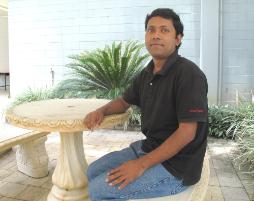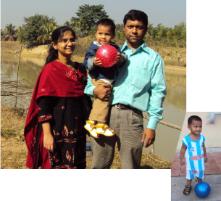An answer for the energy we've been blowing in the wind
Published on 02 December, 2010
If Australia one day makes the transition to renewable energy sources, it could be with help from a man who has endured long periods away from his family to pursue his research.
Born in Bangladesh, where his wife and young son still live, Mohammad Arif took up a scholarship in South Korea in 2006 and had only a short time back in his home country before starting as a PhD candidate at CQUniversity Rockhampton, in March this year.
All this globe-trotting means that family time has been at a premium but there's a chance they might all be reunited in Australia in the New Year. Mohammad's wife is a civil engineer working with the Bangladesh railway's projects and she hopes to enrol in a Masters program at CQUniversity.
Meantime, there's a lot of phone calls and Emails going back and forth across the ocean. During one update, Mohammad was amused to find that both he and his son cheered for Argentina's soccer team during the recent World Cup.
The researcher is now focused on the 'greatest problem' associated with renewable forms of energy, such as wind and solar - the variability of supply.
This means that storage of renewable energy has become the Holy Grail or 'essential enabling technology' for the future.
Mohammad says Australia has great potential for solar and wind energy and it has a bewildering choice of energy storage methods, including pumped hydro, compresed air, thermal, flywheels, hydrogen, batteries, capacitors and superconducting magnetic energy. All these are used in different renewable energy conservation processes.
"The use of intermittent energy sources such as solar and wind can benefit from grid energy storage systems," he said. "While interconnecting renewable energy sources and the storage system to the grid, the grid receives supply from all these sources and, depending on load demand and the energy intensity of wind and solar, output power will vary.
"My study focus is to find the impacts on the grid power quality when the supply comes from storage as well as renewable energy sources and the grid, with a view of developing techniques to overcome these impacts."
Mohammad is a member of our Power Engineering Research Group (PERG) and said that experiments will be conducted at the CSIRO renewable energy integration facility in Newcastle. A computer simulation model will be developed to find the best ways to overcome power quality impacts and it will then be validated at the CSIRO facility.
Longer-term, Mohammad hopes to find work in Australia's renewable energy sector.
-- Mohammad has presented his research during the Institute for Resource Industries and Sustainability (IRIS) Annual Postgraduate Student Conference on Wednesday December 1 at CQUniversity in Rockhampton.



